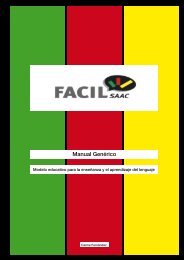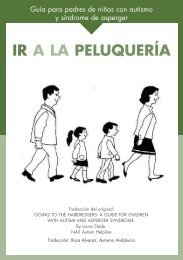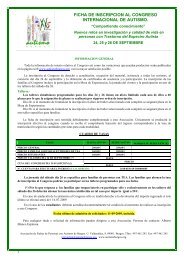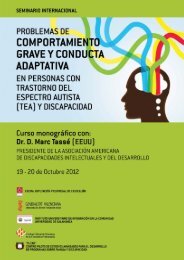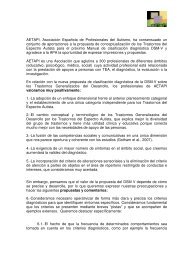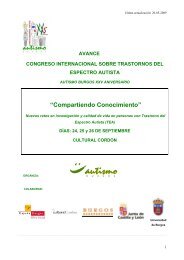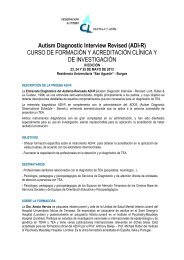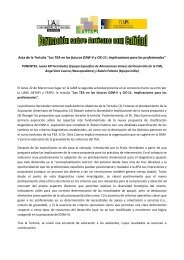persons with autism spectrum disorders - Aetapi
persons with autism spectrum disorders - Aetapi
persons with autism spectrum disorders - Aetapi
You also want an ePaper? Increase the reach of your titles
YUMPU automatically turns print PDFs into web optimized ePapers that Google loves.
6<br />
associated disorder itself needs<br />
treatment.<br />
ASD is normally present from<br />
birth but the age at which<br />
symptoms become evident<br />
varies greatly.<br />
In classical cases of <strong>autism</strong> signs<br />
are evident <strong>with</strong>in the first two<br />
years of life.<br />
ASD in children <strong>with</strong> no<br />
intellectual problems or<br />
significant language delays<br />
may only be recognised when<br />
children begin school and have<br />
difficulties coping <strong>with</strong> the<br />
social demands of school and<br />
their peer group.<br />
Persons <strong>with</strong> higher intellectual<br />
ability and special skills in<br />
certain areas may simply be<br />
considered eccentrics for most<br />
of their lives.<br />
In these cases, ASD may only<br />
be recognised if the person has<br />
a child <strong>with</strong> ASD or symptoms<br />
become more evident if the<br />
person is unable to cope <strong>with</strong><br />
marital problems.<br />
Currently, different clinical<br />
forms of ASD are described:<br />
(see Kanner)<br />
- little or no speech or social<br />
relations; resistance to change;<br />
stereotypical behaviour, physical<br />
dexterity and obsession <strong>with</strong><br />
parts of objects; occasionally<br />
impressive isolated skills.<br />
Persons <strong>with</strong> Autism Spectrum Disorders<br />
include psychiatric <strong>disorders</strong> such as anxiety <strong>disorders</strong> (in up to 60%),<br />
depression and other affective <strong>disorders</strong>, attention deficit hyperactivity<br />
disorder, obsessive-compulsive disorder, tics, catatonia and also,<br />
although more rarely, substance abuse and psychotic breakdown.<br />
A thorough assessment of these features is essential. Many such<br />
problems (for example, depression or anxiety) may reflect the<br />
fact that the environment is inappropriate, or the treatment plan<br />
inadequate for someone <strong>with</strong> ASD. In these cases “comorbidities”<br />
should be considered as “complications”, requiring careful reappraisal<br />
of the intervention programme. In other cases, the associated <strong>disorders</strong><br />
will need treatment in their own right.<br />
Age of onset and impairment<br />
Although in most individuals ASD is present from birth, the age at<br />
which symptoms become clinically evident varies greatly. In classic<br />
cases of ASD, such as described by Kanner, and especially when<br />
associated <strong>with</strong> developmental delay, the first signs will be evident<br />
<strong>with</strong>in the first two years of life. However, very young children who<br />
do not have cognitive impairments, and particularly those who show<br />
no significant language delays (for example those <strong>with</strong> Asperger<br />
syndrome), may be able to function relatively well in one-to-one<br />
relationships at home, <strong>with</strong> sensitive, understanding adults. Recognition<br />
of their impairments may be delayed until the social demands<br />
of school and the need to interact <strong>with</strong> their peer group become too<br />
difficult for them to cope <strong>with</strong>.<br />
The problems associated <strong>with</strong> ASD may also be compensated for,<br />
at least partially, by higher intellectual ability, especially if this is<br />
accompanied by special skills in certain areas. Many individuals <strong>with</strong><br />
Asperger syndrome, for example, succeed well in technical fields such<br />
as engineering or computer technology, and may simply be considered<br />
as somewhat eccentric for much of their lives. In such cases<br />
the diagnosis may only be recognised if the individual later has a<br />
child <strong>with</strong> ASD and that assessment reveals similar problems in the<br />
parent as well. Alternatively, symptoms may become more apparent<br />
when marital problems arise, due to the inability of the person <strong>with</strong><br />
Asperger syndrome to cope <strong>with</strong> the “normal” demands for intimacy<br />
and companionship.



